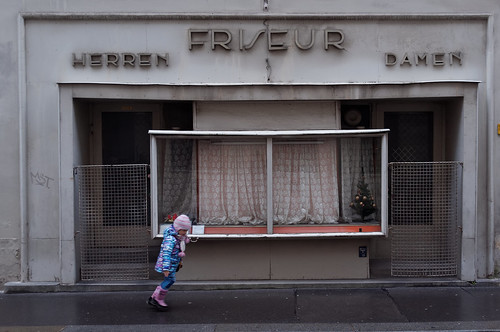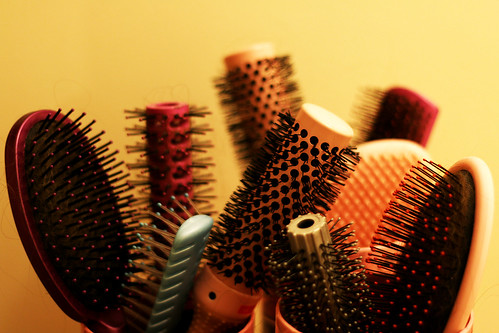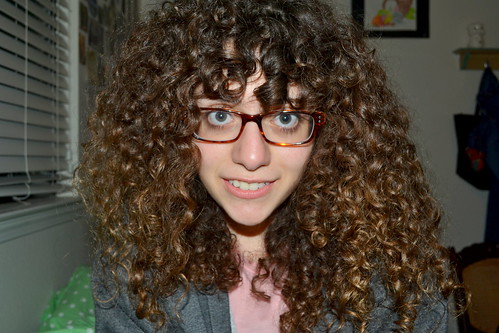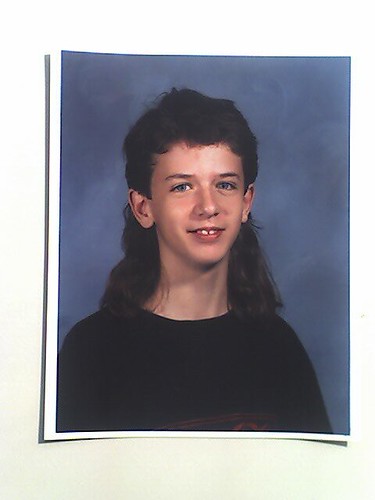The German Mullet and Other Hairstyles Posted by Constanze on Apr 18, 2016 in Language

der Friseur – the hairdresser’s. Herren – men. Damen – women. Photo by station_nord on flickr.com under a CC license (CC BY-ND 2.0)
In my quest to bring you the best German words out there I recently found a great one related to Haare – hair. Someone once said to me that the best kind of business to have is either a coffee shop or a hairdresser’s, because no matter how times change, people will always want coffee and haircuts! With that in mind, I figured a little vocabulary list on hair was in order!
VERBS
schneiden – to cut
waschen – to wash
föhnen – to blowdry (not to be confused with the verb blasen – to blow! You do not want to say this to your hairdresser!)
kämmen – to comb
bürsten – to brush
nachschneiden – to trim
färben – to colour/dye
rasieren – to shave
EQUIPMENT & ACCESSORIES
die Lockenwickler – curlers (rollers)
der Lockenstab – curling tong
das Glätteisen – hair straightener
die Haarspange – hairclip
das Haarband – hairband
das Haarspray – hairspray
der Kamm – comb
die Bürste – brush
*GOOD TO KNOW: While in English we say hair rather than hairs (unless we are talking about individual hairs, such as ‘putting hairs on our chest’, for instance), in German it is acceptable a lot of the time to say either das Haar or die Haare. The plural form (die Haare) is more commonly used, but both are correct. So this sentence: Sie hat lockiges Haar (She has curly hair – using the singular form) is just as acceptable as this sentence: Sie hat lockige Haare (She has curly hair – using the plural form). The difference is that in English we would never say ‘She has curly hairs’, so it can be confusing to hear both being used in German!*
HAIR TYPES
lockig – curly
glatt – straight
kraus/gekräuselt – frizzy
lang – long
kurz – short
gefärbt – dyed
gebleicht – bleached
dick – thick
dünn – thin
PARTS OF THE HAIR
der Haarspliss – split ends
die Wurzeln – roots
der Scheitel – hair parting
der Pony – fringe (not to be confused with the word for ponytail below!)
HAIRSTYLES & HAIRCUTS
die Dauerwelle – perm (literally ‘lasting wave’)
der Pferdeschwanz – ponytail (literally ‘horse’s tail’)
der Zopf – plait/braid
der Dutt – bun
die Glatze – shaved/bald head
der Glatzkopf – shaved/bald head, or referring to the person who has a shaved head (also sometimes called der Kahlkopf)
der Pagenkopf – bob (The English ‘Bob’ is also in use)
die Perücke – wig
der Rattenschwanz – A long strand of hair amongst a short haircut, usually running down the back of the neck. Literally, ‘rat’s tail‘.
I hope you’ve found this vocabulary list useful and interesting! To finish, what is that quirky word that inspired this post? It’s the German word for a mullet, which is Vokuhila. What’s this word all about? Vokuhila is short for Vorne kurz, hinten lang – short at the front, long at the back. Vo-ku-hi-la. 🙂

Build vocabulary, practice pronunciation, and more with Transparent Language Online. Available anytime, anywhere, on any device.
About the Author: Constanze
Servus! I'm Constanze and I live in the UK. I'm half English and half German, and have been writing about German language and culture on this blog since 2014. I am also a fitness instructor & personal trainer.








Comments:
Judy Haran:
Just out of curiosity, is there a name for that weird hairstyle you see on photos of Nazi leaders, which is half shaved (the lower half) and half “short” (the top half)? I have never seen anyone in real life with this hairstyle. What was it called? (You can see it on all closeups of Himmler, for example.)
auslk:
If you need to borrow a hand blow dryer from the hotel, what would say in German to the receptionist when requesting one?
Constanze:
@auslk Simply ask for a Haartrockner (der) or a Föhn (der) – both words for hair dryer!
Max Spring:
Two minor typos:
“razieren” –> “rasieren”
“dunn” –> “dünn”
Cheers,
-Max